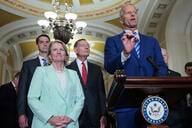You have /5 articles left.
Sign up for a free account or log in.
A full two months after Congress appropriated emergency grants for students through the Coronavirus Aid, Relief and Economic Security (CARES) Act, dollars are finally landing in some students’ bank accounts. But even after all of the funds are disbursed, the program will be overshadowed by implementation challenges caused by the U.S. Department of Education that will require a congressional fix.
It started well enough. Congress came together, setting aside political differences, to provide colleges with the flexibility to accommodate students displaced by the novel coronavirus. The CARES Act provided emergency grants that could be used to help students grappling with unanticipated COVID-19-related expenses. Now, seven weeks since the CARES Act was passed, many institutions are still struggling to disburse emergency grants to students.
Where did things go off the rails?
The department’s initial response to the COVID-19 outbreak was both flexible and expedient. As the country came to grips with the breadth and danger of COVID-19, and colleges reached the point of having to decide whether to suspend operations, the Education Department stood out as a federal agency at the forefront of the pandemic. More than a week before President Donald Trump would declare a national emergency, the department formed a task force to tackle COVID-19-related issues and released guidance that gave institutions relief from the constraints of the federal student aid programs that would adversely impact students. The ability of colleges to transition to online coursework was also helped by the quick release of department guidance.
Higher education institutions -- and then students -- seemed likely to receive these essential funds quickly. But things took a turn for the worse when the department implemented an unnecessarily convoluted process that has caused delays in funding and excluded far too many students from receiving the emergency grants appropriated by Congress.
In early April, Education Secretary Betsy DeVos urged institutions to “develop [their] own system and process for determining how to allocate these funds, which may include distributing the funds to all students or only to students who demonstrate significant need.” But then the department almost immediately narrowed those flexibilities by requiring that emergency grants only be provided to students who would meet, or are currently meeting, the student eligibility requirements for federal student aid. In other words, to receive emergency funds, students will now almost certainly be required to complete a Free Application for Federal Student Aid, or FAFSA, as the most practicable way to determine whether someone is eligible to file a FAFSA is to actually have them file a FAFSA -- or have students open themselves up to possible prosecution by self-certifying that they meet requirements they do not understand.
What does that mean in real terms? Consider the implications:
- Hector, a student who contracted COVID-19 and incurred significant medical expenses because his campus health center had closed -- but also has an unrehabilitated defaulted student loan? Not eligible.
- Elise, a low-income student who had to move off campus unexpectedly due to the virus and also has a minor drug conviction? No grant funds.
- Ana, an international student with no U.S. family, no on-campus housing and concerns about international travel? No assistance.
- William, who needed to buy a laptop to stay enrolled as his college moved to 100 percent distance education but failed to register for Selective Service? He’s not eligible, either.
Narrowly defining eligible students nearly two weeks after colleges signed up for the program was a setback, since many colleges had already developed models to disburse those funds based on broad legislative language, the department’s initial certification agreement -- which did not mention these narrowly defined student eligibility criteria -- and advice from their association counterparts to provide these emergency grants to as many needy students as possible.
The secretary claims that her hands are tied because Congress stipulated that these funds could only go to students eligible for federal student aid. To the contrary, Congress could not have been any clearer on student eligibility when it designed the program, which rested on the simple idea that emergency grants are not federal student aid funds, and not subject to the same terms and conditions. Democratic leaders have since contradicted the secretary’s assertion, crying foul and asking her to reverse course. Republicans have said Congress meant to leave it up to the department to decide who should get emergency help, a far cry from the assertion that they meant these grants to only go to students eligible for federal student aid.
These contradictions to congressional intent would be frustrating even if they were simply a misreading of the law, but clearly, there are political undertones at play. Given that the department made no mention of this requirement in its certification agreement, it appears rather obvious that this change in policy is a back-door way to exclude undocumented students, Deferred Action for Childhood Arrivals recipients and international students. In pursuing a political win, the administration ended up disqualifying entire swaths of other students who did not, or cannot, complete a FAFSA.
The department will not change course, and emergency grants will be gone before this can be litigated. The only viable solution is for Congress to explicitly define eligible students in the most expansive way possible, and to actually tie the secretary’s hands from excluding students whom Congress deems eligible. But Congress shouldn’t stop there. More funding is needed to combat the real threat of summer and fall disruptions. If the first bill was meant to provide immediate help to students to combat emergencies, the next should focus on ensuring students’ enrollments are not disrupted.
Too many students, families and college campuses face truly unprecedented challenges in meeting college expenses next year. Record unemployment will cause financial need to skyrocket. Congress will have to tackle the problem using a combination of additional funding for emergency grants to cover unanticipated student expenses and increases to the existing federal student aid programs. Programs like the Pell Grant, which has experienced surpluses in recent years, will be depleted quickly, and other programs like supplemental grants will need a significant boost to meet demand not seen for more than a decade.
Large-scale missteps have been made, but it’s not too late for Congress to step in and fix. For those of us in the higher education community, it’s been a lesson in political gamesmanship and overreach that will not soon be forgotten.




